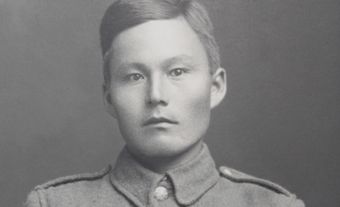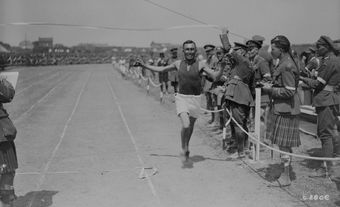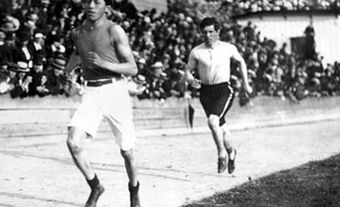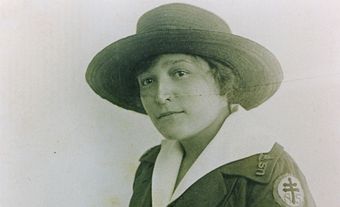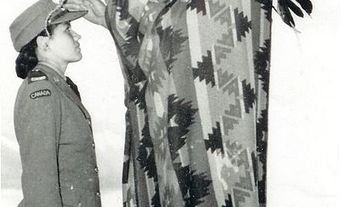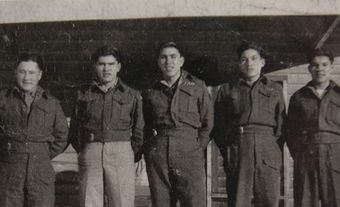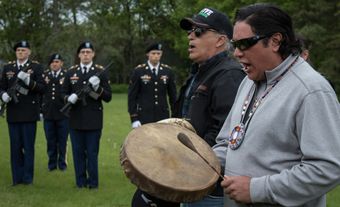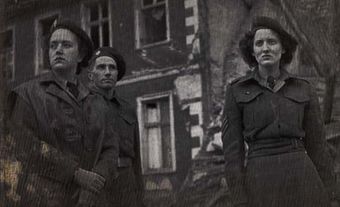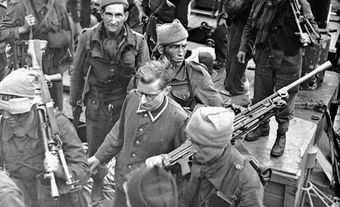Thomas George Prince, war hero, Indigenous advocate (born 25 October 1915 in Petersfield, MB; died 25 November 1977 in Winnipeg, MB). Tommy Prince of the Brokenhead Ojibway Nation is one of the most-decorated Indigenous war veterans in Canada, having been awarded a total of 11 medals for his service in the Second World War and the Korean War. When he died, he was honoured at his funeral by his First Nation, the province of Manitoba, Canada and the governments of France, Italy and the United States. ( See also Indigenous Peoples and the World Wars.)
Early Life
Tommy Prince was born in a canvas tent in Petersfield, Manitoba, in October 1915, one of 11 children born to Henry and Arabella Prince of the Brokenhead band of Ojibwe. He was a descendent of Peguis, the Salteaux chief. When he was five, his family moved to the Brokenhead reserve (now known as Brokenhead Ojibway Nation) in Scanterbury. (See also Reserves in Manitoba.) Prince was a survivor of the residential school system.
Prince learned to be a superb marksman and an excellent tracker on the reserve. His father, a hunter and a trapper, taught him. Prince applied to join the Canadian military several times but was rejected. Indigenous people faced widespread discrimination and that likely played a role in his rejection. He was finally accepted in the early years of the Second World War. (See also Indigenous Peoples and the World Wars.)
Devil's Brigade
Prince enlisted in the Canadian Army on 3 June 1940 and was assigned to the 1st Field Park Company of the Royal Canadian Engineers. By 1942 Prince was a sergeant with the Canadian Parachute Battalion. Posted to the 1st Canadian Special Service Battalion, he was among a select group of Canadian soldiers sent to train with an American unit to form a specialized assault team. They became the 1st Special Service Force (1st SSF), known to the enemy as the "Devil's Brigade." The name was adopted by Hollywood as the title of a 1968 portrayal of the elite unit. Prince was portrayed as "Chief."
Prince distinguished himself with the 1st SSF in Italy and France, using the skills he'd learned growing up on the reserve. He displayed his covert abilities in a celebrated action near the front line in Anzio, Italy. In February 1944, he volunteered to run a communication line 1,400 metres out to an abandoned farmhouse that sat just 200 metres from a German artillery position. He set up an observation post in the farmhouse and for three days reported on German movements via a communication wire.
When the wire was severed during shelling, he disguised himself as a peasant farmer and pretended to work the land around the farmhouse. He stooped to tie his shoes and fixed the wire while German soldiers watched, oblivious to his true identity. At one point, he shook his fist at the Germans, and then at the Allies, pretending to be disgusted with both. His actions resulted in the destruction of four German tanks that had been firing on Allied troops.
In France in the summer of 1944, Prince endured a gruelling trek across rugged terrain to locate an enemy camp. He travelled without food or water for 72 hours. He returned to the Allied position and led his brigade to the German encampment, resulting in the capture of more than 1,000 German soldiers.
Did You Know?
In 2020, an online campaign launched in support of honouring Tommy Prince as the face of a new design of the five-dollar bill.
Honoured by King George VI
When the fighting ended in France, Prince was summoned to Buckingham Palace, where King George VI decorated him with the Military Medal (MM) and, on behalf of the American president, the Silver Star with ribbon. He would also receive the 1939-1945 Star, the Italy Star, the France and Germany Star, the Defence Medal, the Canadian Volunteer Service Medal with Clasp and the War Medal.
Prince was one of 59 Canadians who were awarded the Silver Star during the Second World War, only three of whom also possessed the Military Medal. Tommy Prince was honourably discharged on 15 June 1945 and returned to Canada.
Back in Canada
At home, Prince faced racism from the Canadian government. As an Indigenous man, he was not allowed to vote in federal elections — in spite of his wartime service — and was refused the same benefits as other Canadian veterans. (See also Indigenous Suffrage.)
He started a business, which briefly prospered. He left it in the hands of friends so he could serve as a spokesman for the Manitoba Indian Association, where he lobbied the federal government to change the Indian Act. (See also Indigenous Political Organization and Activism in Canada.) Following his campaigning, he came home to discover that the business he'd entrusted to friends had failed in his absence.
Facing unemployment and discrimination, he re-enlisted in the military and served with the Princess Patricia's Canadian Light Infantry (PPCLI).
Service in Korea
Prince resumed his former rank and began training new recruits for the Korean War. He was then part of the first Canadian unit to land in Korea, where he served with a PPCLI rifle platoon. In Korea, Prince led many “snatch patrols,” where a small group of soldiers would travel into enemy territory and launch sneak attacks before retreating. One overnight raid led to the capture of two enemy machine guns.
Suffering from bad knees, Prince returned to Canada for treatment in 1951. But he went back to Korea for a second tour in 1952. He was injured again and spent weeks in hospital, where he was still recovering when the Korea Armistice came into force in 1953, ending the fighting.
He returned to Canada and remained in the army, serving at Winnipeg’s personnel depot, until September 1954, when he was honourably discharged.
For his two tours of duty in Korea, Prince was awarded the Canadian Korea Medal and the United Nations Service Medal (Korea). Posthumously, he also became entitled to the Canadian Volunteer Service Medal for Korea, created in 1991.
Did You Know?
On 17 October 2022, Canada Post released a stamp honouring the life and legacy of Tommy Prince. The stamp features Prince in his Korean War uniform, with the Northern lights in the background
Hard Times
Prince had a strong sense of civic duty and a fierce pride in his people. He dedicated himself to attaining increased educational and economic opportunities for Indigenous peoples. “All my life I had wanted to do something to help my people recover their good name. I wanted to show they were as good as any white man,” he said.
He was married and had five children. In 1955, he saw a man drowning at the Alexander Docks in Winnipeg and leapt in to save him.
Prince fell on hard times and spent his last years living in a Salvation Army shelter. (See also Social Conditions of Indigenous Peoples in Canada.) He died at the Deer Lodge Hospital in Winnipeg on 25 November 1977. He was 62. Prince was buried in Brookside Cemetery, a military gravesite in Winnipeg. A delegation of the Princess Patricia’s served as his pallbearers. Men from his First Nation chanted the “Death of a Warrior” song as he was lowered into the grave. More than 500 people attended his funeral, including Manitoba’s lieutenant governor and the consuls from France, Italy and the US.
Legacy and Significance
Tommy Prince is one of the most decorated Indigenous war veterans in Canada. Aside from his significant military contributions to this country, he is also remembered as an Indigenous advocate who fought for equality and Indigenous rights. Prince’s nephew, Jim Bear, told CBC News in 2020 that he remembers his uncle as “a visionary” who was in favour of abolishing the Indian Act, something Bear points out “we're still trying to change.”

 Share on Facebook
Share on Facebook Share on X
Share on X Share by Email
Share by Email Share on Google Classroom
Share on Google Classroom






